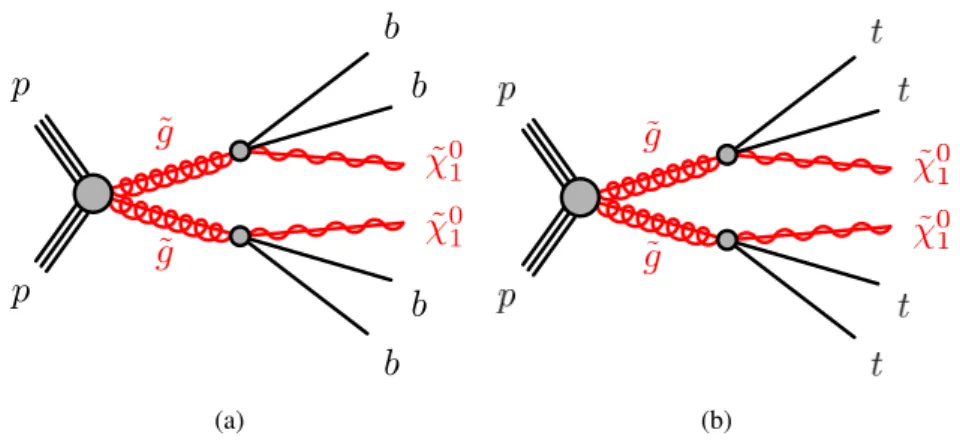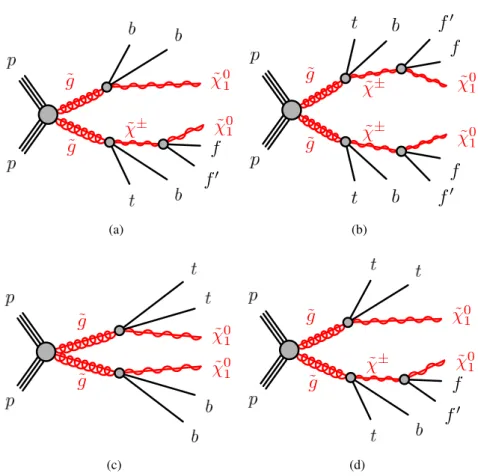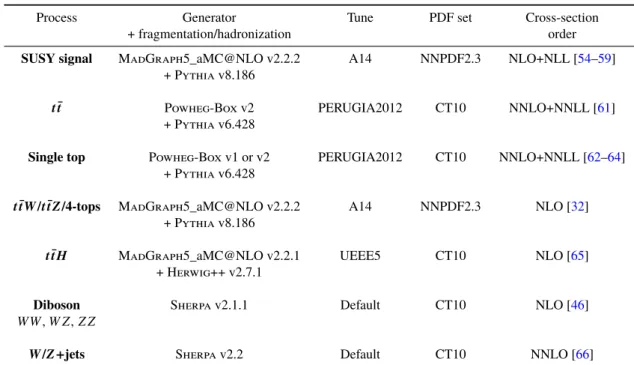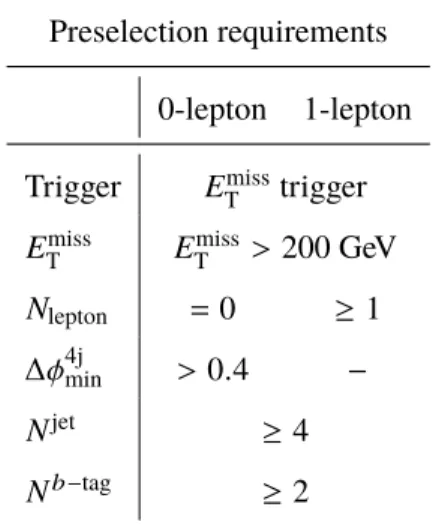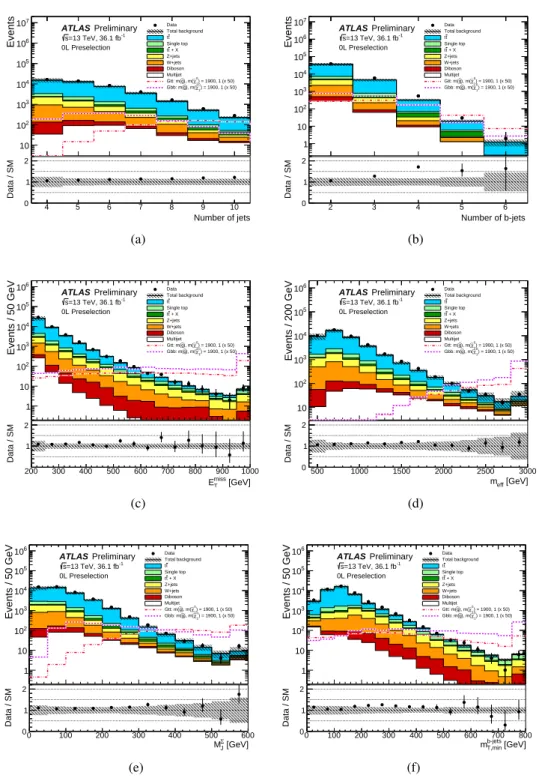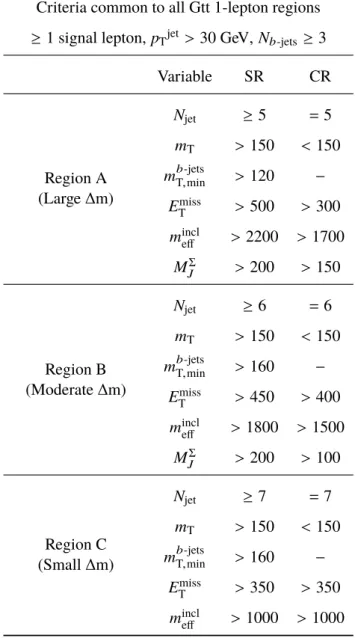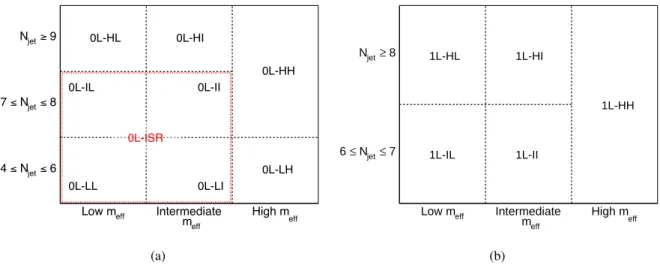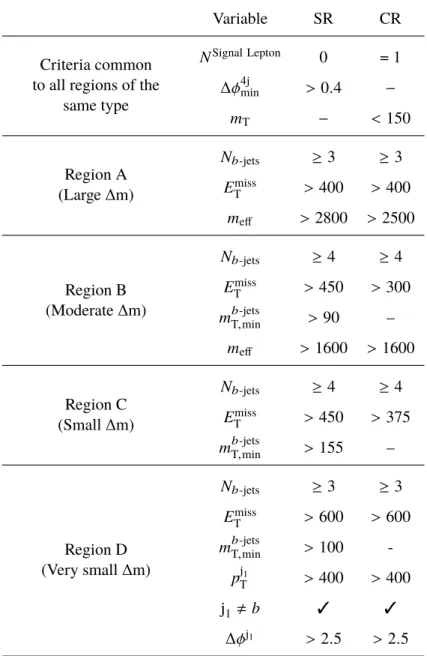ATLAS-CONF-2017-021 03April2017
ATLAS CONF Note
ATLAS-CONF-2017-021
Search for production of supersymmetric particles in final states with missing transverse momentum and multiple b-jets at √
s = 13 TeV proton-proton collisions with the ATLAS detector
The ATLAS Collaboration
24th March 2017
A search for supersymmetry involving the pair production of gluinos decaying via third- generation squarks to the lightest neutralino ( ˜χ0
1) is reported. It uses LHC proton–proton collision data at a centre-of-mass energy
√s = 13 TeV with an integrated luminosity of 36.1 fb−1 collected with the ATLAS detector in 2015 and 2016. The search is performed in events containing large missing transverse momentum and several energetic jets, at least three of which must be identified as originating fromb-quarks. To increase sensitivity, the sample is divided depending on the presence or absence of electrons or muons. No excess is found above the predicted background. For ˜χ0
1 masses below approximately 300 GeV, gluino masses of less than 1.97 (1.92) TeV are excluded at the 95% CL in simplified models involving the pair production of gluinos that decay via top (bottom) squark. An interpretation of the limits in terms of the branching ratios of the gluinos into third generation squarks is also provided. These results significantly extend the exclusion limits obtained with the 3.2 fb−1of data collected in 2015.
© 2017 CERN for the benefit of the ATLAS Collaboration.
Reproduction of this article or parts of it is allowed as specified in the CC-BY-4.0 license.
1 Introduction
Supersymmetry (SUSY) [1–6] is a generalisation of space-time symmetries that predicts new bosonic partners to the fermions and new fermionic partners to the bosons of the Standard Model (SM). IfR-parity is conserved [7], SUSY particles are produced in pairs and the lightest supersymmetric particle (LSP) is stable. The scalar partners of the left- and right-handed quarks, the squarks ˜qLand ˜qR, can mix to form two mass eigenstates ˜q1 and ˜q2, ordered by increasing mass. SUSY can suppress the scale hierarchy [8–11]
reducing unnatural tuning in the Higgs sector by orders of magnitude, provided that the superpartners of the top quark (stop, ˜t1 and ˜t2) have masses not too far above the weak scale. Because of the SM weak isospin symmetry, the mass of the left-handed bottom quark scalar partner (sbottom, ˜bL) is tied to the mass of the left-handed top quark scalar partner (˜tL), and as a consequence the mass of the lightest sbottom ˜b1is also expected to be close to the weak scale. The fermionic partners of the gluons, the gluinos ( ˜g), are also motivated by naturalness [12] to have a mass around the TeV scale in order to limit their contributions to the radiative corrections to the stop quark masses. For these reasons, and because the gluinos are expected to be pair-produced with a high cross-section at the Large Hadron Collider (LHC), the search for gluino production with decays via stop and sbottom quarks is highly motivated at the LHC.
This note presents the search for gluino pair production decaying via stop or sbottom quarks in events with multiple jets originating from the hadronisation ofb-quarks (b-jets in the following), high missing transverse momentum of magnitude Emiss
T , and potentially additional light quark jets and/or an isolated charged lepton1. The dataset consists of 36.1 fb−1 of proton–proton collision data collected with the ATLAS detector [13] at a center-of-mass energy of 13 TeV in the years 2015 and 2016. Interpretations are provided in the context of several effective simplified models probing various gluino decays to third-generation squarks and the LSP. The latter is assumed to be the lightest neutralino ˜χ0
1, a linear superposition of the superpartners of the neutral electroweak and Higgs bosons. The results supersede the ones obtained using 3.2 fb−1of data collected in 2015 using the same strategy [14]. Pair-produced gluinos with stop-mediated decays have also been searched for using events containing pairs of same-sign leptons or three leptons in the 2015 ATLAS dataset [15]. The same-sign/three lepton search obtains comparable sensitivities to the search presented in this note when the masses of the gluino and the LSP are very close to each other. Similar searches performed in the CMS experiment using 13 TeV data [16–23] have produced comparable results to ATLAS searches.
2 SUSY signal models
Various simplified SUSY models [24,25] are employed to optimize the event selection and/or interpret the results of the search. In terms of experimental signature, they all contain at least fourb-jets originating from either gluino or top quark decays, and two ˜χ0
1, which escape the detector unseen, resulting in high Emiss
T .
Gluinos are assumed to be pair-produced and to decay either as ˜g →b˜1bor ˜g →t˜1t. The following stop and sbottom decays are then considered: ˜t1 → tχ˜0
1, ˜t1 → bχ˜±
1 and ˜b1 → bχ˜0
1. In all cases, the stop
1The term “lepton” refers exclusively to an electron or a muon in this note.
or sbottom are assumed to be off-shell in order to have simplified models with only two parameters: the gluino and ˜χ0
1masses2. All other sparticles are decoupled.
Two simplified models are used to optimise the event selection in addition to interpreting the results. In the Gbb (Gtt) model, illustrated in Figure1(a) (1(b)), each gluino undergoes an effective three-body decay g˜ → bb¯χ˜0
1 ( ˜g →tt¯χ˜0
1) via off-shell sbottom (stop) quarks, with a branching ratio of 100%. The Gbb model is the simplest in terms of object multiplicity, resulting in the minimal common features of four b-jets and two ˜χ0
1. In addition to these objects, the Gtt model produces fourWbosons originating from the top quark decays: t →W b. The presence of these fourW bosons motivates the design of signal regions with a higher jet multiplicity than for Gbb models, and in some cases with at least one isolated electron or muon.
˜ g
˜ g p
p
˜ χ01 b
b
˜ χ01
b b
(a) (b)
Figure 1: The decay topologies in the (a) Gbb and (b) Gtt simplified models.
This note includes a novel interpretation that probes the sensitivity of the search as a function of the gluino branching ratio, in addition to the gluino and ˜χ0
1 masses. For that interpretation a third gluino decay is considered: ˜g → tbχ˜±
1 (via the off-shell stop decay ˜t1 → bχ˜±
1). The ˜χ±
1 is then forced to decay as χ˜±
1 →W∗χ˜0
1 → ff¯0χ˜0
1(where f stands for a fermion). To keep the numbers of model parameters at only two, the mass difference between the ˜χ±
1 and the ˜χ0
1is fixed to 2 GeV. Such a small mass splitting between the ˜χ±
1 and the ˜χ0
1is typical of models where the ˜χ0
1is Higgsino-like (see e.g. Ref. [27]), which are well motivated by naturalness. Consequently, the products of the decayW∗ → ff¯0 are typically too soft to be detected, except for very large mass differences between the gluino and the ˜χ±
1. Thus, in this model, the gluino can decay as either ˜g → bb¯χ˜0
1, ˜g →tbχ˜±
1 (with ˜χ±
1 → ff¯0χ˜0
1) or ˜g → t¯tχ˜0
1, with the sum of individual branching ratios adding up to 100%. This model probes more realistic scenarios where the branching ratio to either ˜g→bb¯χ˜0
1or ˜g→t¯tχ˜0
1is not 100%, and where one, two or three top quarks, and thus on-shellWbosons, are possible in the final state, in-between the Gbb (no top quarks) and Gtt (four top quarks) decay topologies. The decay topologies that are considered in the variable branching ratio model are illustrated in Figure2. The model also includes the Gbb and Gtt decay topologies illustrated in Figure1. A limited set of 10 mass points are generated for this variable branching ratio model withmg˜ varying from 1.5 TeV to 2.3 TeV andm
χ˜0
1varying from 1 GeV to 1 TeV.
The technical implementation of the simulated samples produced from these models is described in Section4.
2Models with on-shell sbottom and stop were studied in Run 1 [26] and the limits on the gluino and the ˜χ0
1masses were found to be mostly independent of the stop and sbottom masses, except when the stop is very light.
(a) (b)
(c) (d)
Figure 2: The additional decay topologies of the varying gluino branching ratio model in addition to the ones of Figure 1. The fermions originating from the ˜χ±
1 decay are typically soft because the mass difference between the
χ˜±
1 and the ˜χ0
1is fixed to 2 GeV.
3 ATLAS detector
The ATLAS detector is a multipurpose particle physics detector with a forward-backward symmetric cylindrical geometry and nearly 4πcoverage in solid angle.3 The inner tracking detector (ID) consists of silicon pixel and microstrip detectors covering the pseudorapidity region|η| < 2.5, surrounded by a transition radiation tracker, which enhances electron identification in the region|η| < 2.0. Before the start of Run 2, the new innermost pixel layer, the Insertable B-Layer (IBL) [28], was inserted at a mean sensor radius of 3.3 cm. The ID is surrounded by a thin superconducting solenoid providing an axial 2 T magnetic field and by a fine-granularity lead/liquid-argon (LAr) electromagnetic calorimeter covering |η| < 3.2.
A steel/scintillator-tile calorimeter provides coverage for hadronic showers in the central pseudorapidity range (|η| < 1.7). The endcaps (1.5 < |η| < 3.2) of the hadronic calorimeter are made of LAr active layers with either copper or tungsten as the absorber material. The forward region (3.1 < |η| < 4.9) is instrumented with a LAr calorimeter for both EM and hadronic measurements. A muon spectrometer with an air-core toroid magnet system surrounds the calorimeters. Three layers of high-precision tracking
3ATLAS uses a right-handed coordinate system with its origin at the nominal interaction point in the centre of the detector.
The positivex-axis is defined by the direction from the interaction point to the center of the LHC ring, with the positivey-axis pointing upwards, while the beam direction defines thez-axis. Cylindrical coordinates(r, φ)are used in the transverse plane,φ being the azimuthal angle around thez-axis. The pseudorapidityηis defined in terms of the polar angleθbyη=−ln tan(θ/2).
chambers provide coverage in the range|η| < 2.7, while dedicated fast chambers allow triggering in the region |η| < 2.4. The ATLAS trigger system [29] consists of a hardware-based Level-1 trigger (L1) followed by a software-based High Level Trigger (HLT).
4 Data and simulated event samples
The data used in this analysis were collected by the ATLAS detector from pp collisions produced by the LHC at a centre-of-mass-energy of 13 TeV and 25 ns proton bunch spacing over the 2015 and 2016 data-taking periods. The full dataset corresponds to an integrated luminosity of 36.1 fb−1after requiring that all detector subsystems were operational during data recording. The uncertainty in the combined 2015+2016 integrated luminosity is 3.2%. It is derived, following a methodology similar to that detailed in Ref. [30], from a preliminary calibration of the luminosity scale using x–y beam-separation scans performed in August 2015 and May 2016. Events are required to pass an Emiss
T trigger [31] with lower thresholds of 70 GeV, 100 GeV and 110 GeV at the HLT level for the 2015, early and late 2016 datasets, respectively. These triggers are fully efficient for events passing the preselection defined in Section6, which requires the offline reconstructed Emiss
T to exceed 200 GeV. There are on average 13.7 and 24.9 inelasticppcollisions (“pileup”) in the same bunch crossing in the 2015 and 2016 data, respectively.
Simulated event samples are used to model the signal and background processes in this analysis, except multijet processes which are estimated from data. SUSY signal samples in which each gluino decays to bbχ˜0
1,ttχ˜0
1, ortbχ˜0
1are generated with up to two additional partons using MadGraph5_aMC@NLO [32]
v2.2.2 at leading order (LO) with NNPDF 2.3 [33] parton density function (PDF) sets. These samples are interfaced to Pythia v8.186 [34] for the modelling of the parton showering, hadronisation and underlying event.
The dominant background in the signal regions is the production oft¯tpairs with additional high transverse momentum (pT) jets. For the generation oftt¯and single top-quarks in theW t- ands-channels the Powheg- Box [35] v2 generator with the CT10 [36] PDF sets in the matrix element calculations is used. Electroweak t-channel single top-quark events are generated using the Powheg-Box v1 generator. This generator uses the four-flavour scheme for the NLO matrix elements calculations together with the fixed four-flavour PDF set CT10f4. For all processes involving top quarks, top-quark spin correlations are preserved. In thet-channel, top quarks are decayed using MadSpin [37]. The parton shower, fragmentation, and the underlying event are simulated using Pythia 6.428 [38] with the CTEQ6L1 PDF sets. Thehdampparameter in Powheg, which controls thepTof the first additional emission beyond the Born level and thus regulates thepTof the recoil emission against thet¯tsystem, is set to the mass of the top quark (mtop =172.5 GeV).
All events with at least one leptonically decayingW boson are included. Fully hadronict¯tand single top events do not contain sufficientEmiss
T to contribute significantly to the background.
Smaller backgrounds in the signal region come from the production of tt¯ pairs in association with W/Z/h bosons and possibly additional jets, production ofttt¯¯t,W/Z+jets andW W/W Z/Z Z (diboson) events. Other potential source of backgrounds, such as the production of three top quarks or three gauge bosons, are expected to be negligible. The production oft¯t pairs in association with electroweak vec- tor bosonsW and Z are modeled by samples generated at LO using MadGraph5_aMC@NLO v2.2.2 and showered with Pythia v8.186, while samples to modeltt H¯ production are generated using Mad- Graph5_aMC@NLO v2.2.1 and showered with Herwig++ [39] v2.7.1. These samples are described in detail in Ref. [40]. MadGraph5_aMC@NLO is also used to simulate thet¯ttt¯production and the shower- ing is performed with Pythia v8.186. W/Z+jets processes are simulated using the Sherpa v2.2 [41]
generator, while Sherpa v2.1.1 is used to simulate diboson production processes. Matrix elements for theW/Z+jets and diboson processes are calculated using the Comix [42] and OpenLoops [43] generators and merged with the Sherpa parton shower [44] using the ME+PS@NLO prescription [45]. The Sherpa diboson sample cross section has been scaled down to account for its use ofαQED=1/129 rather than 1/132, corresponding to the use of current PDG parameters, as input to theGµ scheme [46]. Samples generated using MadGraph5_aMC@NLO v2.2.2 are produced with NNPDF 2.3 PDF sets, while all other samples are generated with CT10 PDFs.
For all samples, except the ones generated using Sherpa, the EvtGen v1.2.0 program [47] is used to simulate the properties of the bottom and charm-hadron decays. All Pythia v6.428 samples use the PERUGIA2012 (P2012) [48] set of tuned parameters (tune) for the underlying event, while Pythia v8.186 and Herwig++ showering are run with the A14 [49] and UEEE5 [50] underlying-event tunes, respectively.
In-time and out-of-time pileup interactions from the same or nearby bunch-crossings are simulated by overlaying additionalppcollisions generated by Pythia v8.186, using the A2MSTW2008LO underlying- event tune [51], on top of the hard-scattering events. Details of the sample generation and normalization are summarized in Table1. Additional samples with different generators and settings are used to estimate systematic uncertainties on the backgrounds, as described in Section8.
All simulated event samples are passed through the full ATLAS detector simulation using Geant4 [52], with the exception of signal samples in which both gluinos do not only decay tottχ˜0
1, which are passed through a fast simulation that uses a parameterised description to simulate the response of the calorimeter systems [53]. The simulated events are reconstructed with the same algorithm as that used for data.
The signal samples are normalised using the best cross-sections calculated at NLO in the strong coupling constant, adding the resummation of soft gluon emission at next-to-leading-logarithmic (NLL) accuracy [54–58]. The nominal cross-section and the uncertainty are taken from an envelope of cross-section predictions using different PDF sets and factorisation and renormalisation scales, as described in Ref. [59].
The cross-section of gluino pair-production in these simplified models is(14±3)fb for a gluino mass of 1.5 TeV, falling to(1.0±0.3)fb for 2 TeV mass gluinos. All background processes are normalised to the best available theoretical calculation for their respective cross-sections. The order of this calculation in perturbative QCD (pQCD) for each process is listed in Table1.
Finally, contributions from multijet background are estimated from data using a procedure described in [60], which perfoms the smearing of the jet response in data events with well-measured Emiss
T (so-called
"seed events"). The response function is derived in MC dijet events and is different forb-tagged and non-b-tagged jets.
5 Object reconstruction
Interaction vertices from the proton–proton collisions are reconstructed from at least two tracks with pT > 0.4 GeV, and are required to be consistent with the beamspot envelope. The primary vertex is identified as the one with the largest sum of squares of the transverse momenta from associated tracks (P
|pT,track|2) [67].
Basic selection criteria are applied to define candidates for electrons, muons and jets in the event. An overlap removal procedure is applied to these candidates to prevent double-counting. Further requirements are then made to select the final signal leptons and jets from the remaining objects. The details of the object selections and of the overlap removal procedure are given below.
Process Generator Tune PDF set Cross-section
+ fragmentation/hadronization order
SUSY signal MadGraph5_aMC@NLO v2.2.2 A14 NNPDF2.3 NLO+NLL [54–59]
+ Pythia v8.186
tt¯ Powheg-Box v2 PERUGIA2012 CT10 NNLO+NNLL [61]
+ Pythia v6.428
Single top Powheg-Box v1 or v2 PERUGIA2012 CT10 NNLO+NNLL [62–64]
+ Pythia v6.428
t¯tW/t¯t Z/4-tops MadGraph5_aMC@NLO v2.2.2 A14 NNPDF2.3 NLO [32]
+ Pythia v8.186
tt H¯ MadGraph5_aMC@NLO v2.2.1 UEEE5 CT10 NLO [65]
+ Herwig++ v2.7.1
Diboson Sherpa v2.1.1 Default CT10 NLO [46]
W W,W Z,Z Z
W/Z+jets Sherpa v2.2 Default CT10 NNLO [66]
Table 1: List of generators used for the different processes. Information is given about the underlying-event tunes, the PDF sets and the pQCD highest-order accuracy used for the normalization of the cross-section the different samples.
Candidate jets are reconstructed from three-dimensional topological energy clusters [68] in the calorimeter using the anti-kt jet algorithm [69] with a radius parameter of 0.4 (small-Rjets). Each topological cluster is calibrated to the electromagnetic scale response prior to jet reconstruction [70]. The reconstructed jets are then calibrated to the particle level by the application of a jet energy scale (JES) derived from
√s = 13 TeV data and simulations [71]. Quality criteria are imposed to reject events that contain at least one jet arising from non-collision sources or detector noise [72]. Further selections are applied to reject jets that originate from pileup interactions by the means of a multivariate algorithm using the information about the tracks matched to each jet [73]. Candidate jets are required to have pT >20 GeV and|η| <2.8. After resolving overlaps with electrons and muons, selected jets are required to satisfy the stricter requirement ofpT>30 GeV.
A jet is tagged as a b-jet by means of a multivariate algorithm using information about the impact parameters of inner detector tracks matched to the jet, the presence of displaced secondary vertices, and the reconstructed flight paths ofb- and c-hadrons inside the jet [74, 75]. The b-tagging working point corresponding to an efficiency of 77% to identifyb-jets with pT > 20 GeV, as determined from a sample of simulatedt¯tevents, was found to be optimal for this search. The corresponding rejection factors against jets originating fromc-quarks, fromτ-leptons and from light quarks and gluons in the same sample at this working point are 6, 22 and 134, respectively.
After resolving the overlap with leptons, the candidate small-Rjets are re-clustered [76] into large-R jets using the anti-kt algorithm with a radius parameter of 0.8. The calibration from the input small-Rjets propagates directly to the re-clustered jets. These re-clustered jets are then trimmed [76–79] by removing subjets whosepTfalls below 10% of thepT of the original re-clustered jet. The resulting large-Rjets are required to havepT >100 GeV and|η| < 2.0. When it is not explicitly stated otherwise, the term “jets”
in this note refers to small-Rjets.
Electron candidates are reconstructed from energy clusters in the electromagnetic calorimeter and inner detector tracks and are required to satisfy a set of “loose” quality criteria [80,81]. They are also required to have|η| <2.47. Muon candidates are reconstructed from matching tracks in the inner detector and in the muon spectrometer. They are required to meet “medium” quality criteria, as described in Ref. [82], and to have|η| < 2.5. All electron and muon candidates must havepT >20 GeV. Leptons are selected from the candidates that survive the overlap removal procedure if they fulfill a requirement on the scalar sum ofpTof additional inner detector tracks in a cone around the lepton track. This isolation requirement is defined to ensure a flat efficiency of around 99% across the whole electron transverse energy and muon transverse momentum ranges. The angular separation between the lepton and theb-jet ensuing from a semi-leptonic top quark decay narrows as thepTof the top quark increases. This increased collimation is accounted for by setting the radius of the isolation cone to min(0.2, 10 GeV/plep
T ), whereplep
T is the lepton pT expressed in GeV. Selected electrons are further required to meet the “tight” quality criteria [80,81].
Electrons (muons) are matched to the primary vertex by requiring the transverse impact parameterd0of the associated ID track to satisfy|d0|/σd0 <5 (3), whereσd0is the measured uncertainty ofd0, and the longitudinal impact parameter z0 to satisfy|z0sinθ| < 0.5 mm4. In addition, events containing one or more muon candidates with|d0|(|z0|)>0.2 mm (1 mm) are rejected to suppress cosmic rays.
Overlaps between candidate objects are removed sequentially. Firstly, electron candidates that lie within
∆R < 0.015 from muon candidates are removed to suppress contributions from muon bremsstrahlung.
Overlaps between electron and jet candidates are resolved next, and finally, overlaps between remaining jets and muon candidates are removed.
Overlap removal between electron and jet candidates aims to resolve two sources of ambiguity: it is designed, firstly, to remove jets that are formed primarily from the showering of a prompt electron and, secondly, to remove electrons that are produced in the decay chains of hadrons. Consequently, any non-b- tagged jet whose axis lies within∆R<0.2 from an electron is discarded. Electrons withET <50 GeV are discarded if they lie within∆R< 0.4 to the axis of any remaining jet and the corresponding jet is kept. For higher-ETelectrons, the latter removal is performed using a threshold of∆R=min(0.4,0.04+10 GeV/ET) to increase the acceptance for events with collimated top quark decay.
The overlap removal procedure between muon and jet candidates is designed to remove those muons that are likely to have originated from the decay of hadrons and to retain the overlapping jet. Jets and muons may also appear in close proximity when the jet results from high-pT muon bremsstrahlung, and in such cases the jet should be removed and the muon retained. Such jets are characterized by having very few matching inner detector tracks. Therefore, if the angular distance∆Rbetween a muon and a jet is lower than 0.2, the jet is removed if it is notb-tagged and has fewer than three matching inner detector tracks.
As for the electrons, muons withpTbelow (above) 50 GeV are subsequently discarded if they lie within
∆R=0.4 (∆R=min(0.4,0.04+10 GeV/pT)) of any remaining jet.
The missing transverse momentum (Emiss
T ) in the event is defined as the magnitude of the negative vector sum (p~Tmiss) of the transverse momenta of all selected and calibrated objects in the event, with an extra term added to account for energy deposits that are not associated to any of these selected objects. This
“soft” term is calculated from inner detector tracks matched to the primary vertex to make it more resilient to contamination from pileup interactions [83,84] .
4Both transverse and longitudinal impact parameters are defined with respect to the selected primary vertex.
5∆R=q
(∆y)2+(∆φ)2defines the distance in rapidityyand azimuthal angleφ.
Corrections derived from data control samples are applied to simulated events to account for differences between data and simulation in the reconstruction efficiencies, momentum scale and resolution of leptons, in the efficiency and false positive rate for identifying b-jets, and in the efficiency for rejecting jets originating from pileup interactions.
6 Event preselection
The event selection criteria are defined based on kinematic requirements on the objects defined in Section5 and on the following event variables.
The effective mass variable (meff) is defined as:
meff =X
i
pTjeti +X
j
p`j
T +Emiss
T ,
where the first and second sums are over the selected jets (Njet) and leptons (Nlepton), respectively. It typically has a much higher value in pair-produced gluino events than in background events.
In regions with at least one selected lepton, the transverse massmT composed of the pT of the leading selected lepton (`) andEmiss
T is defined as:
mT=q 2p`
TEmiss
T {1−cos[∆φ(p~miss
T ,~p`
T)]}.
It is used to discriminate between the signal and backgrounds from semi-leptonictt¯andW+jets events.
Neglecting resolution effects, themTdistribution for these backgrounds is bounded from above by theW boson mass and typically has higher values for Gtt events. Another useful transverse mass variable is mb-jets
T,min, the minimum transverse mass formed byEmiss
T and any of the three highest-pTb-tagged jets in the event:
mb-jets
T,min=mini≤3
q 2pb-jeti
T Emiss
T {1−cos[∆φ(~pmiss
T ,~pb-jeti
T )]}
! .
It is bounded from above by the top quark mass for semi-leptonict¯tevents, while peaking at higher values for Gbb and Gtt events.
The total jet mass variable is defined as:
MJΣ=X
i≤4
mJ,i,
where mJ,i is the mass of the large-radius re-clustered jet i in the event. The decay products of a hadronically-decaying boosted top quarks can be reconstructed in a single large-radius re-clustered jet, resulting in a jet with a high mass. This variable will typically have larger values for Gtt events, which contain as much as four hadronically-decaying top quarks, then background, which is dominated by semi-leptonic and di-leptonictt¯events.
The requirement of a selected lepton, with the additional requirements on jets,Emiss
T and event variables described in Section7, makes the multijet background negligible for the≥ 1-lepton signal regions. For
the 0-lepton signal regions, the minimum azimuthal angle between ~pmiss
T and thepT of the leading four small-Rjets in the event, denoted∆φ4jmin, defined as:
∆φ4jmin=mini≤4
|φjeti −φ~pmiss
T
| ,
is required to be greater than 0.4. This requirement ensures that the multijet background, which can produce events with largeEmiss
T if containing poorly measured jets or neutrinos emitted close to the axis of a jet, is also negligible in most of the 0-lepton signal regions (along with the other requirements on jets, Emiss
T and event variables described in Section7).
A similar variable, denoted∆φj1 is also used in the Gbb signal regions targeting small mass differences between the gluino and the neutralino, allowing for the identification of events containing a high-pT jet coming from initial state radiation (ISR) and recoiling against the gluino pair. It is defined as the absolute value of the azimutal angle separating thepT of the leading jet and ~pmiss
T , and is expected to have larger values for the targeted signal than for the background.
Preselection criteria in the 0-lepton and 1-lepton channels are defined in Table2. They require Emiss
T >
200 GeV, in addition to theEmiss
T trigger requirement, and at least four jets of which at least two must be b-tagged. The 0-lepton channel has a veto on the number of selected leptons, and the 1-lepton channel requires at least one selected lepton.
Preselection requirements 0-lepton 1-lepton Trigger Emiss
T trigger Emiss
T Emiss
T > 200 GeV
Nlepton =0 ≥ 1
∆φ4jmin >0.4 −
Njet ≥4
Nb−tag ≥2
Table 2: Definition of the preselection criteria.
Correction factors are extracted to account for shape discrepancies in themeff spectrum between the data and background expectations for the 1-lepton preselection sample. These factors are defined as the ratio of the number of observed events to the predicted number of background events in a givenmeff bin, in a signal-depleted region. This region is defined by the 1-lepton preselection criteria plus requiring exactly twob-tagged jets andmb-jets
T,min < 140 GeV. This kinematic reweighting leads to correction factors ranging from 0.7 to 1.1. They are applied to the background prediction and the full size of the correction is taken as an uncertainty for both the background and signal events.
Figures3and4show the multiplicity of selected jets andb-jets, and the distributions forEmiss
T ,meff,MJΣfor events passing the 0-lepton or the 1-lepton preselection, respectively. Figure3(4) also displays the distri- bution ofmb-jets
T,min(mT) in the 0-lepton (1-lepton) channel. The correction described above is applied in the
1-lepton channel. The uncertainty bands include the statistical and experimental systematic uncertainties, as described in Section8, but not the theoretical uncertainties on the background modelling.
The agreement between data and background prediction is found to be reasonable at the preselection level after the kinematic reweighting described above. A discrepancy between data and expectation is observed for the number of b-tagged jets, but it has a negligible impact on the background estimate after the renormalization of the simulation in dedicated control regions with the sameb-tagged jets requirements as the signal regions, as described in Section7. Example signal models with enhanced cross-sections are overlaid for comparison.
7 Analysis strategy
In order to enhance sensitivity to the various signal benchmarks described in Section2, multiple signal regions (SRs) are designed. The main background source in all these regions is the associated production of att¯pair together with heavy and light flavour jets. While the normalisation of non-t¯t backgrounds is taken from the theory prediction, thet¯tnormalisation for each individual SR is extracted from a data control region (CR) that has comparable background composition and kinematics. This is ensured by keeping similar kinematic requirements between both regions, and exactly the same selection on Nb-jets. CRs and SRs are defined to be mutually exclusive. Signal contribution in the CRs is suppressed by reverting or relaxing some requirements on the kinematic variables (e.g. mT,mb-jets
T,min), leading to a signal contamination in the CRs of 6% at most. Thet¯t normalisation is cross-checked in validation regions (VRs) that share similar background composition, i.e. jet and lepton flavours, with the SR. The signal contamination in the VRs has been checked to be lower than 30% for benchmark signal mass points above the already excluded mass range.
Two analysis strategies are followed, and different SR sets are defined for each:
• acut-and-count analysis, using partially-overlapping single-bin SRs, optimised to maximise the expected discovery power for benchmark signal models and being easily recastable. The SRs are defined to probe the existence of a signal or to assess model-independent upper limits on the number of signal events;
• amulti-bin analysis, using a set of non-overlapping SRs and CRs that are combined together to strengthen the exclusion limits on the targeted signal benchmarks. This set of regions is used to assess model-dependent interpretations of the various signal models.
7.1 Cut-and-count analysis
SRs targeting the Gtt model in the 1-lepton channel are presented in Table 3. The region labelled A is optimised for signals with a large mass difference (∆m) betwen the gluino and the neutralino (∆m & 1.5 TeV), possibly leading to highly boosted objects in the final state. Conversely, region C primarily focuses on signals for which the gluino decay products are softer due to the small ∆m (∆m . 300 GeV). Region B targets intermediate values of ∆m. As can be seen from Table 3 these regions differ mainly in their kinematic selections thresholds: meff, Emiss
T andMJΣ selections are relaxed when going from region A to C to improve the acceptance for softer signals. The resulting background increase is compensated by tightening the requirements on the number of (b-tagged) jets ormb-jets
T,min.
Number of jets
4 5 6 7 8 9 10
Events
10 102
103
104
105
106
107
ATLAS Preliminary
=13 TeV, 36.1 fb-1
s 0L Preselection
Data Total background
t t Single top
+ X t t Z+jets W+jets Diboson Multijet
) = 1900, 1 (x 50) 0 χ∼1 ), m(
~g Gtt: m(
) = 1900, 1 (x 50) 0 χ∼1 ), m(
g~ Gbb: m(
Number of jets
4 5 6 7 8 9 10
Data / SM
0 1 2
(a)
Number of b-jets
2 3 4 5 6
Events
1 10 102
103
104
105
106
107
ATLAS Preliminary
=13 TeV, 36.1 fb-1
s 0L Preselection
Data Total background
t t Single top
+ X t t Z+jets W+jets Diboson Multijet
) = 1900, 1 (x 50) 0 χ∼1 ), m(
~g Gtt: m(
) = 1900, 1 (x 50) 0 χ∼1 ), m(
g~ Gbb: m(
Number of b-jets
2 3 4 5 6
Data / SM
0 1 2
(b)
[GeV]
miss
ET
200 300 400 500 600 700 800 900 1000
Events / 50 GeV
1 10 102
103
104
105
106
ATLAS Preliminary
=13 TeV, 36.1 fb-1
s 0L Preselection
Data Total background
t t Single top
+ X t t Z+jets W+jets Diboson Multijet
) = 1900, 1 (x 50) 0 χ∼1 ), m(
~g Gtt: m(
) = 1900, 1 (x 50) 0 χ∼1 ), m(
g~ Gbb: m(
[GeV]
miss
ET
200 300 400 500 600 700 800 900 1000
Data / SM
1 2
(c)
[GeV]
meff
500 1000 1500 2000 2500 3000
Events / 200 GeV
10 102
103
104
105
106 ATLAS Preliminary
=13 TeV, 36.1 fb-1
s 0L Preselection
Data Total background
t t Single top
+ X t t Z+jets W+jets Diboson Multijet
) = 1900, 1 (x 50) 0 χ∼1 ), m(
~g Gtt: m(
) = 1900, 1 (x 50) 0 χ∼1 ), m(
g~ Gbb: m(
[GeV]
meff
500 1000 1500 2000 2500 3000
Data / SM
0 1 2
(d)
[GeV]
Σ
MJ
0 100 200 300 400 500 600
Events / 50 GeV
1 10 102
103
104
105
106
ATLAS Preliminary
=13 TeV, 36.1 fb-1
s 0L Preselection
Data Total background
t t Single top
+ X t t Z+jets W+jets Diboson Multijet
) = 1900, 1 (x 50) 0 χ∼1 ), m(
~g Gtt: m(
) = 1900, 1 (x 50) 0 χ∼1 ), m(
g~ Gbb: m(
[GeV]
Σ
MJ
0 100 200 300 400 500 600
Data / SM
0 1 2
(e)
[GeV]
b-jets T,min
m
0 100 200 300 400 500 600 700 800
Events / 50 GeV
1 10 102
103
104
105
106
ATLAS Preliminary
=13 TeV, 36.1 fb-1
s 0L Preselection
Data Total background
t t Single top
+ X t t Z+jets W+jets Diboson Multijet
) = 1900, 1 (x 50) 0 χ∼1 ), m(
~g Gtt: m(
) = 1900, 1 (x 50) 0 χ∼1 ), m(
g~ Gbb: m(
[GeV]
b-jets T,min
m
0 100 200 300 400 500 600 700 800
Data / SM
0 1 2
(f)
Figure 3: Distributions of (a) the number of selected jets (Njet), (b) the number of selectedb-jets, (c)Emiss
T , (d)meff, (e)MJΣand (f)mT,minb-jetsfor events passing the 0-lepton preselection criteria. The statistical and experimental systematic uncertainties (as defined in Section8) are included in the uncertainty band. The last bin includes overflows. The lower part of each figure shows the ratio of data to the background prediction. All backgrounds (includingtt¯) are normalized using the best available theoretical calculation described in Section4. The background categorytt¯+X includesttW¯ /Z,tt h¯ andt¯ttt¯events. Example signal models with cross-sections enhanced by a factor of 50 are overlaid for comparison.
